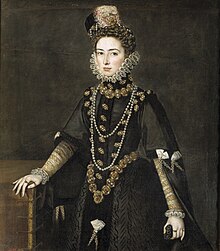Catalina Micaela of Spain
| Catherine Michelle | |
|---|---|
 Portrait by Sofonisba Anguissola | |
| Duchess consort of Savoy | |
| Tenure | 18 March 1585 – 6 November 1597 |
| Born | 10 October 1567 Madrid, Spain |
| Died | 6 November 1597 (aged 30) Turin, Italy |
| Burial | |
| Spouse | |
| Issue Detail |
|
| House | Habsburg |
| Father | Philip II, King of Spain |
| Mother | Elisabeth of Valois |
| Religion | Roman Catholicism |
Catalina Micaela of Spain (Spanish: Catalina Micaela de Austria; 10 October 1567 – 6 November 1597) was a duchess of Savoy who ruled the duchy as regent several times during the absence of her husband, Charles Emmanuel I. She was the younger surviving daughter of Philip II of Spain and Elisabeth of Valois.
Early life[]
Catalina Micaela was the daughter of Philip II, ruler of the vast Spanish Empire, and his third wife, the French princess Elisabeth of Valois.[1] She was described as beautiful, intelligent, arrogant and well aware of her high social status. Though her father did not attend her christening and was not as rejoiced at the birth of a daughter as he had been with her elder sister, Isabella Clara Eugenia, she had a good relationship with him. Philip and Catherine Michelle exchanged letters throughout her life. She had a close relationship with her sister. They were raised together under the care of Margarita de Cardona, the lady-in-waiting of their stepmother, Anna of Austria, and some of her mother's own ladies such as Claude de Vineulx. Her grandmother Catherine de' Medici got regular reports of Catherine and her sister and she had their portraits sent and put in her book of hours. She was probably named after Catherine de Medici.

Duchess consort of Savoy[]
Duke Charles Emmanuel I of Savoy suggested that he should marry Catalina Micaela as a way of gaining Spanish support for his plans to expand Savoy on the coast of the then weakened France. The wedding took place in Zaragoza on 11 March 1585 and the couple made their entrance to Turin in Savoy 10 August 1585.
Catalina Micaela was initially unpopular because of her arrogance and attempts to introduce Spanish pomp, ceremony and way of dress to the court in Turin. However, she soon gained respect because of her political and diplomatic skill, which she used to defend the autonomy of Savoy against Spain. She refused the Spanish offer to install a Spanish garrison in Turin from Milan with the excuse of giving her a life guard. She is reported to have had great influence on Charles Emmanuel I and to have reformed him for the better. She also served as regent several times during the absence of the duke on military campaigns, such as during the Lyon campaign in 1594. Catherine Michelle also benefited cultural life in Savoy, founded many new buildings including an art gallery. Due to her influence, her sons were educated in Spain.

Catalina Micaela died near the end of 1597; she had miscarried earlier that year. Her father died the following year.
Children[]
In 1584, she married Charles Emmanuel I, Duke of Savoy.[2] This marriage produced ten children:
- Philip Emmanuel, Prince of Piedmont (1586–1605)
- Victor Amadeus (1587–1637)[3]
- Emanuel Filibert of Savoy, (1588–1624), Spanish Viceroy of Sicily, (1622–24).[3]
- Margaret (1589–1655), married Francesco IV Gonzaga of Mantua
- Isabella (1591–1626), married Alfonso III d'Este, duke of Modena
- Maurice, a cardinal (1593–1657)
- Maria Apollonia, a nun in Rome (1594–1656)
- Francesca Caterina, a nun in Biella (1595–1640)
- Thomas Francis, Prince of Carignano (1596–1656), Founder of the House of Savoy-Carignano and ancestor of the erstwhile ruling Family of Italy
- Giovanna (born 1597)
Ancestry[]
| showAncestors of Catalina Micaela of Spain |
|---|
References[]
- ^ Pitts 2009, p. 311.
- ^ Bercé 1996, p. 8.
- ^ Jump up to: a b Rapelli 2011, p. 265.
Sources[]
- Bercé, Yves-Marie (1996). The Birth of Absolutism: A History of France, 1598-1661. MacMillan Press Ltd.
- Pitts, Vincent Joseph (2009). Henri IV of France: His Reign and Age. Johns Hopkins University Press.
- Rapelli, Paola (2011). Symbols of Power in Art. Getty Publications.
| Wikimedia Commons has media related to Caterina Micaela of Spain. |
- 1567 births
- 1597 deaths
- 16th-century Spanish people
- 16th-century Spanish women
- 16th-century House of Habsburg
- Nobility from Madrid
- Austrian princesses
- Spanish infantas
- Duchesses of Savoy
- Deaths in childbirth
- Portuguese infantas
- 16th-century women rulers
- Children of Philip II of Spain
- Spanish people of Austrian descent
- Castilian infantas
- Aragonese infantas
- Sofonisba Anguissola
